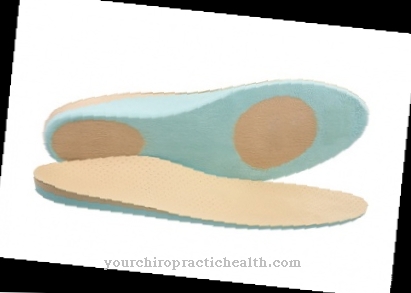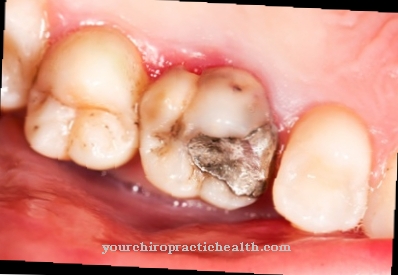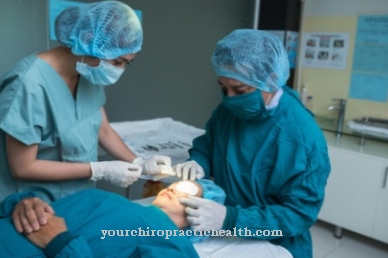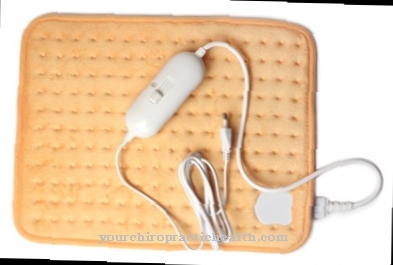Bone cement is a two-component adhesive, which is created before use by mixing a powder with a liquid within a short time. It is used for the elastic anchoring of artificial endoprostheses to the bones. After the implants have been inserted, the artificial joints can be used again immediately thanks to the properties of the bone cement.
What is bone cement?
Bone cement is an adhesive that can bond artificial endoprostheses firmly and elastically to the joint. It is a polymer made from methyl methacrylate. Methyl methacrylate or PMMA is a widespread material, also known as plexiglass. PMMA connects two materials very firmly and is also very elastic at the same time. It is precisely these properties that make this adhesive ideal for the stable bonding of components that are exposed to constant mechanical stress. This is especially true for artificial joints.
Apart from the exhaustion caused by the operation, the patient is fully resilient immediately after inserting the implant, since the material is not only highly elastic but also has a high degree of elasticity. However, changing the implant can be difficult because the bone cement is difficult to remove.
Bone cement has been used successfully for the insertion of artificial joints since the middle of the 20th century. This applies to all joints such as the knee joint, hip joint, elbow joint or shoulder joint. Today, bone cement is routinely used because it is convenient and easy to use in clinical practice.
Shapes, types & types
Bone cement is a uniform material, which is a polymer made of methyl methacrylate. It is created by an exothermic polymerization reaction after mixing together two components, which are known as binders and hardeners. It is a powder and a liquid. The liquid consists of a solution of the monomer, while the powder contains the activating substance.
The polymerization proceeds with the development of heat. After the two components have been mixed, a doughy paste is created, which turns into an elastic glass-like substance. This substance is the actual bone cement.
There are only differences in the composition of the bone cement with regard to the addition of antibiotics such as gentamicin to prevent local infections at the surgical site. The addition of antibiotics is adjusted individually.
Furthermore, the bone cement also contains different proportions of so-called contrast agents in order to be able to display them in imaging procedures such as X-ray examinations. Barium sulfate or zirconium dioxide are used as contrast media.
Structure & functionality
During the operation, the bone cement is mixed by mixing powder and liquid. When heat is generated, a doughy mass is created that is poured into the bones. All cavities are mixed with this mass and thus closed. The prosthesis is then carefully embedded in this doughy substance. There is an increasing increase in viscosity, the cement mass hardening and forming a matrix. This permanently fixes the artificial joint. The cement is still flexible enough to guarantee the mechanical load-bearing capacity of the prosthesis.
The heat of reaction during cement formation can increase up to 70 degrees Celsius. However, the organism can only tolerate a maximum temperature of 42 to 46 degrees Celsius. Above this temperature there is a denaturation of body protein. To ensure this low temperature, the surgical procedure must be so precise that it is possible to use very thin layers of bone cement. With a layer less than five millimeters, the heat dissipation is sufficient due to the larger surface to protect the surrounding tissue. The heat is also dissipated via the large surface of the prosthesis and via the blood stream.
You can find your medication here
➔ Medicines for painMedical & health benefits
The use of bone cement has proven to be very successful in clinical practice. The patients can be quickly remobilized after the operation. The prosthesis can quickly be fully loaded. The material is very stable and durable, so the long-term results are very good. The mechanical resilience is also very high from the start due to the elasticity of the bone cement.
It is also advantageous that antibiotics can be added to the powder before the components are mixed, which effectively prevent infections at the surgical site. After the operation, these active ingredients are slowly released and thus exert a local influence. The release is so low that a local antibiotic effect is guaranteed, but the entire organism is not burdened with antibiotics. Joint surgery should only be performed without the use of bone cement if there is a known allergy to antibiotics.
In rare cases, the operation can lead to a drop in blood pressure and oxygen saturation. A vasodilating effect of cement through the formation of gases during polymerisation is being discussed. Overall, the use of bone cement is part of the medical routine due to its high success rate.
However, when a denture has to be replaced, bone cement often proves to be stubborn. If there is no infection, the cement does not have to be completely removed. In the event of an infection, however, a radical replacement of the bone cement is necessary. However, according to the knowledge available today, it is easier to remove cement than to replace cement-free prostheses that have grown well into the bone bed.




























